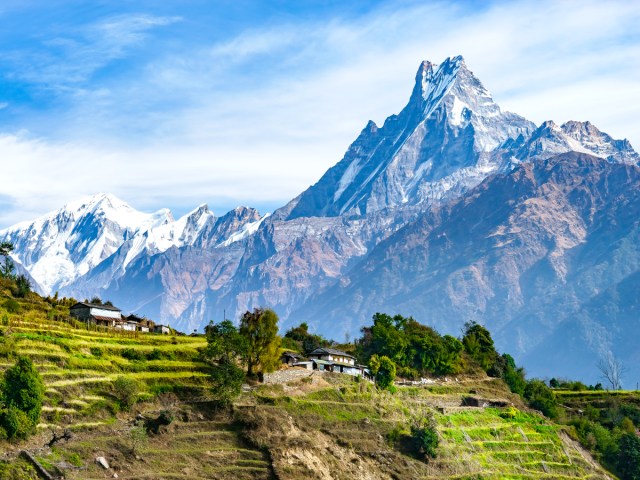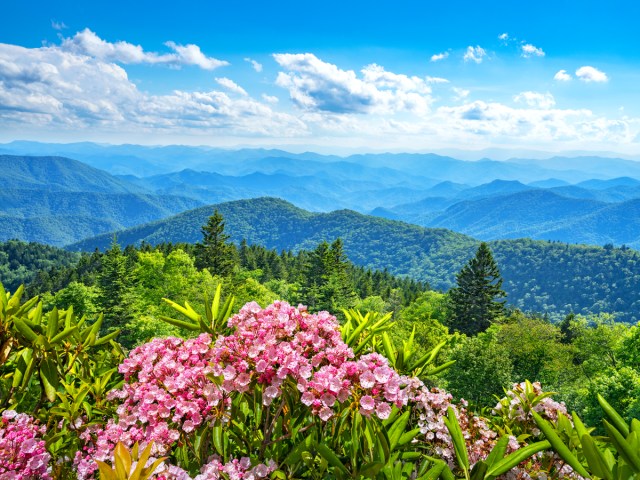Mountain ranges are the backbone of Earth’s continents. Millions of years old, these immense formations can stretch across one or multiple countries. They have the ability to influence climates, ecosystems, and human development. Some ranges continue to grow in size, while erosion has caused others to leave behind dramatic peaks, canyons, and valleys. It’s no surprise, then, that humans have long been drawn to mountains for their mysticism and majesty. Here’s where to find the longest mountain ranges on the planet.
7. Himalayas – Asia (1,550 Miles)

The highest mountain range on Earth, the Himalayas stretch in a crescent shape across Pakistan, India, Nepal, Bhutan, and China. The Himalayas were formed around 50 million years ago when tectonic plate activity caused present-day India to collide into Tibet. The range is home to nine of the world’s 10 tallest mountains, including Mount Everest. This colossal, 29,032-foot-high peak is named after British surveyor Sir George Everest. Another Brit, Sir Edmund Hilary, became the first documented person to reach the summit in 1953, alongside Sherpa mountaineer Tenzing Norgay.
Outside of Antarctica and the Arctic, the Himalayas possess the planet’s largest deposits of ice and snow. The range shelters some 15,000 glaciers, including the 47-mile-long Siachen Glacier in India. It’s also the source of three major rivers: the Indus, the Ganges, and the Brahmaputra. Montane grassland, temperate coniferous forests, and tropical and subtropical boreal forests all flourish throughout the range. This provides a habitat for unique species such as snow leopards and red pandas.
6. Appalachian Mountains – North America (2,000 miles)

The Appalachian Mountains are one of the three major mountain ranges of the United States, along with the Rockies and the Sierra Nevada. Formed some 480 million years ago, the Appalachians create a natural border between the Coastal Plains and Interior Lowlands of North America. They were once estimated to be as tall as the Rockies or even the Himalayas, but they all but disappeared when the Pangea supercontinent split approximately 200 million years ago. Volcanic and tectonic activity about 65 million years ago caused a regrowth, although continual erosion reduced the range’s height.
Today, the Appalachians run from Labrador and Newfoundland, Canada, to Georgia in the U.S. They cross 14 states, and West Virginia is the only state entirely within the range. At 6,684 feet tall, Mount Mitchell in North Carolina is the highest point in the range. The iconic Appalachian Trail, stretching around 2,190 miles between Maine and Georgia, is the longest hiking-only footpath in the world. Standout highlights of the trail include Clingmans Dome in Great Smoky Mountains National Park and the alpine tundra of the Presidential Range in New Hampshire.
5. Great Dividing Range – Australia (2,200 Miles)

Also called the Eastern Highlands, the Great Dividing Range stretches along almost the entire length of Australia’s east coast. It starts in Cape York, the country’s northernmost tip, and finishes near Grampians National Park, in Western Victoria. Believed to be around 300 million years old, the Great Dividing Range is also one of Earth’s oldest ranges. Today, around three-quarters of the Australian population inhabits its western foothills, as well as its eastern escarpment and the connecting coastal regions. It’s a source of fresh water to some 11 million people, including those living in Melbourne and Sydney.
The range possesses immense geological and biological diversity, from dense forests and rivers to rolling hills, mountain plateaus, and tropical wetlands. Amazingly, about 70% of the country’s endangered animal species are found here. They include the grey-headed flying fox, koala, leadbetter’s possum, and southern cassowary. Some of the most emblematic locations within the range are Blue Mountains National Park and Mount Kosciuszko. Rife with tourism activities such as hiking and mountain biking, both are also sacred sites for Australia’s Indigenous peoples.
4. Transantarctic Mountains – Antarctica (2,200 Miles)

The Transantarctic Mountains split the world’s fifth-largest continent into the regions of East Antarctica and West Antarctica. The range extends the entire width of Antarctica between the Ross Sea and Weddell Sea. Formed during the Cenozoic period roughly 65 million years ago, the range is technically a collection of various smaller mountain ranges. These include the Queen Alexander Range, which features 14,856-foot-tall Mount Fitzpatrick. Other notable peaks are Mount Elizabeth and Mount Markham. All were documented during the first British Antarctic Expedition from 1907 to 1909.
Like the entire continent, the Transantarctic Mountains are marked by an extreme, inhospitable climate. Consequently, there is little to no plant life, and vegetation is limited to algae, bacteria, lichen, and fungi. However, wildlife including seabirds, seals, and penguins all inhabit the Ross Sea coastline in the western foothills. Despite the remote location, it’s possible to witness the majesty of these mountains on an Antarctica cruise. Tours depart from Ushuaia, the southernmost city of Argentina, and navigate the treacherous Drake Passage on a multiday journey to the frozen continent.
3. Rocky Mountains – North America (3,000 Miles)

The Rockies connect British Columbia, Canada, with New Mexico in the southwest United States. Geologists estimate that the range originated during the Laramide orogeny between 55 million and 80 million years ago. Collision of tectonic plates and constant erosion from glaciers and rivers has sculpted a landscape defined by glaciers, valleys, and colossal peaks. There are more than 100 peaks in the Rockies exceeding 9,800 feet in the range, including Colorado’s 14,440-foot Mount Elbert and British Columbia’s 12,970-foot Mount Robson.
Wildlife thrives in the varied ecosystems of the Rocky Mountains. Black and grizzly bears, cougars, moose, and wolves roam the landscape, while eagles, ospreys, and peregrine falcons fly high above. The range has also been the home of Indigenous nations for thousands of years. Among them are the Blackfoot and Shoshone peoples, who retain spiritual connections with the mountains and possess invaluable knowledge about its ecosystems. For outdoor adventures, Banff National Park, Yellowstone National Park, and the renowned ski resorts of Colorado are a few popular destinations.
2. Great Escarpment – Africa (3,100 Miles)

The Great Escarpment is a mountain range that divides the highland plateau from the coastline of southern Africa. Mostly located in South Africa and Lesotho, the range also forms a natural border between Zimbabwe and Mozambique, and it stretches westward into Namibia and Angola. The escarpment appeared around 180 million years ago, when tectonic activity reshaped the landscape. Geologically, it’s a blend of hard basalt rocks and softer sandstone. The escarpment is defined by dramatic cliffs and plateaus mostly caused by headwater erosion of rivers and coastal plains.
South Africa’s UNESCO-listed Drakensberg is one of the escarpment’s most dominant features. This mountain range is home to the country’s tallest peaks, rugged cliffs, and lush valleys. It’s also South Africa’s main watershed and the source of the Orange River. Baboons inhabit its woodlands, while the giant eland antelope roams the savannas. Tugela Falls, at 3,110 feet, is the world’s second-tallest waterfall and a highlight of Royal Natal National Park.
1. Andes – South America (4,300 Miles)

Beginning in western Venezuela and finishing in Chile’s Patagonia region, the Andes are the world’s longest mountain range, stretching for approximately 4,300 miles (though some sources estimate that figure to be closer to 5,500 miles). Vital to the history and geology of South America, the Andes pass through seven countries along the western edge of the continent.
The mountains formed when the South American plate and Nazca plate collided and created the Andean Volcanic Belt. This is the highest range in the Western Hemisphere, with 22,840-foot Aconcagua in Argentina as its tallest point. The range features several volcanoes, including Cotopaxi in Ecuador, Ubinas in Peru, and the active Ojos del Salado on the border of Argentina and Chile.
Potatoes and tomatoes originated in the Andes. The mountains are also the cradle of some of the world’s oldest and most advanced pre-Columbian civilizations, including the Incas, who built their iconic home at Machu Picchu in Peru. The Andes are the source of the Amazon River and home to the world’s biggest salt flat, Salar de Uyuni in Bolivia. Over 30,000 plant species and 3,700 animal species thrive amid the mountains. Among the many endemic animals are the Andean condor, spectacled bear, guanaco, and vicuńa.
More from our network
Daily Passport is part of Inbox Studio, which publishes content that uplifts, informs, and inspires.
















